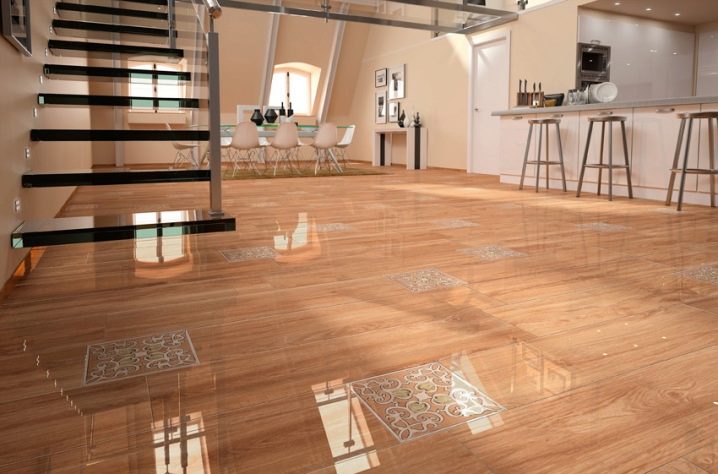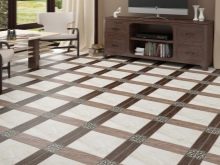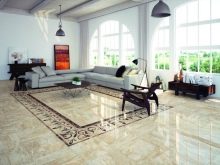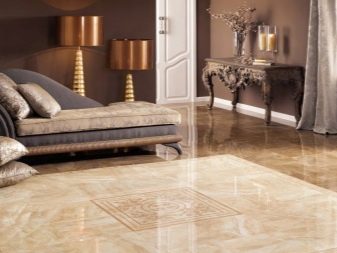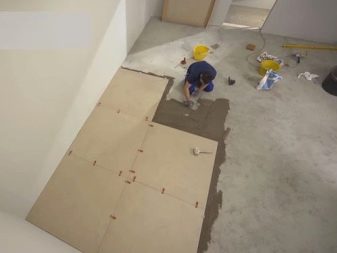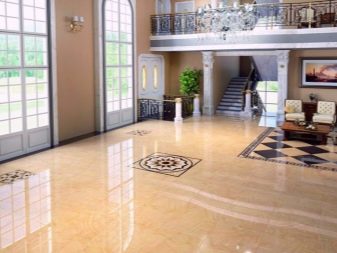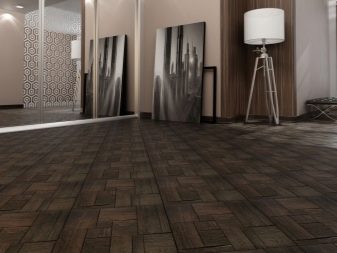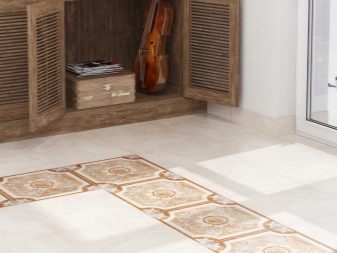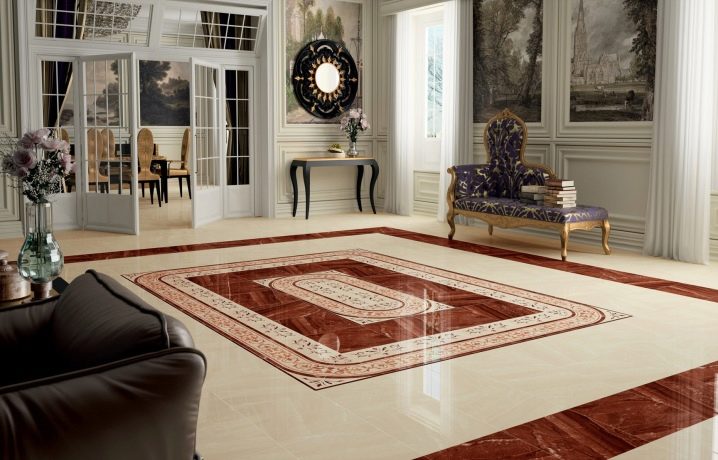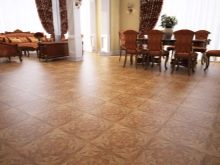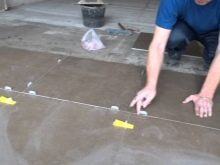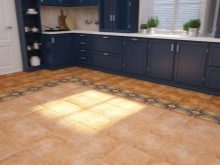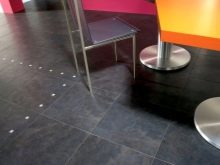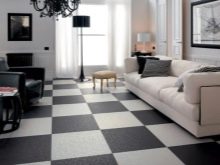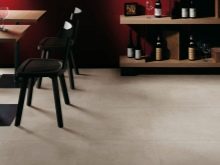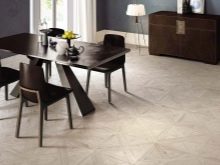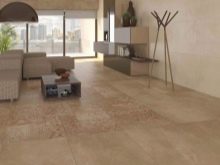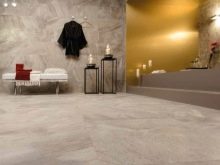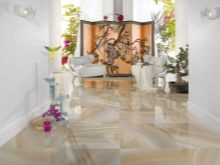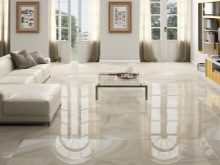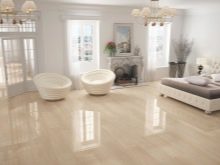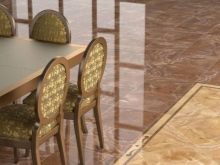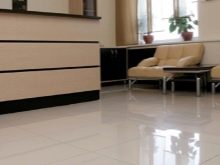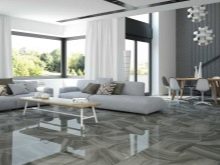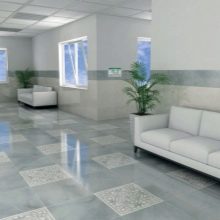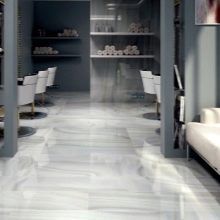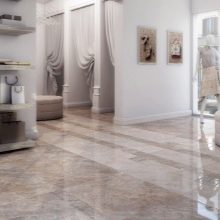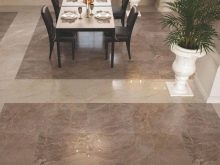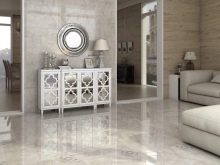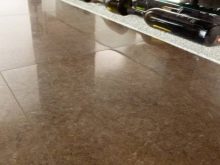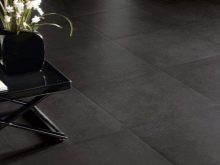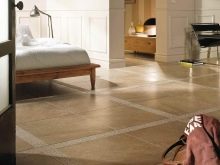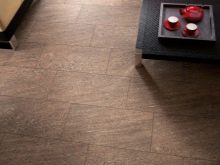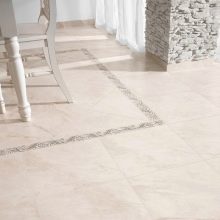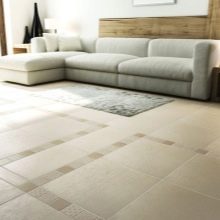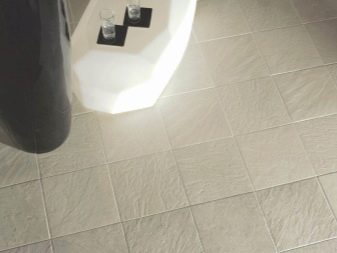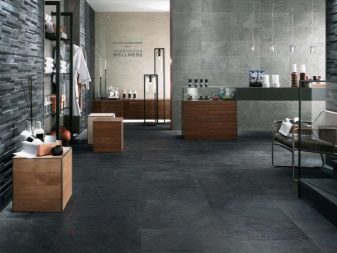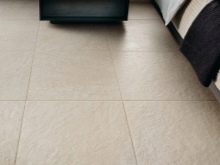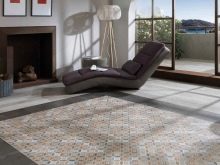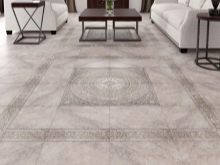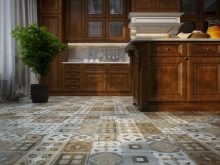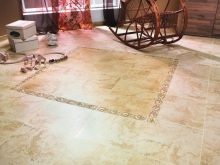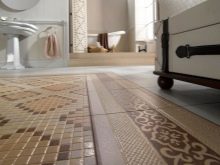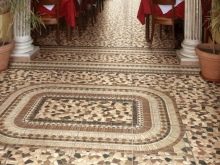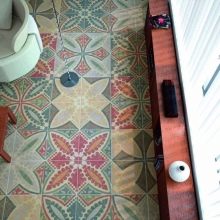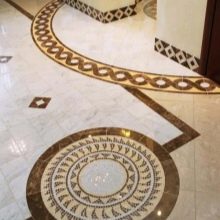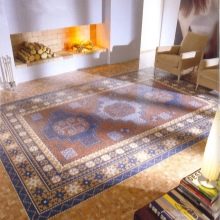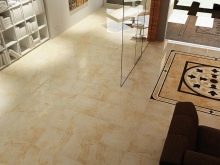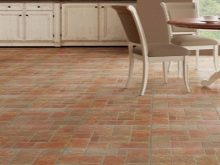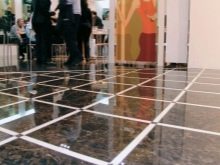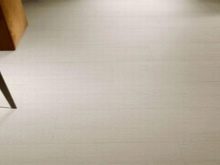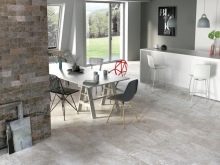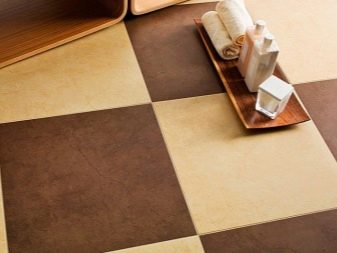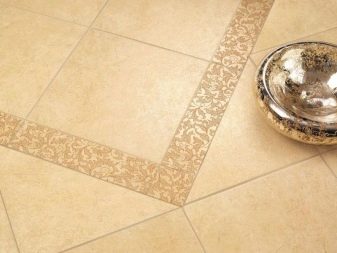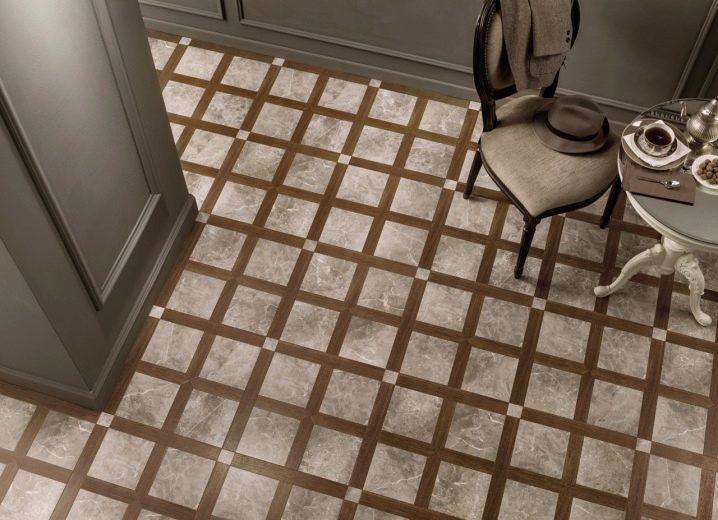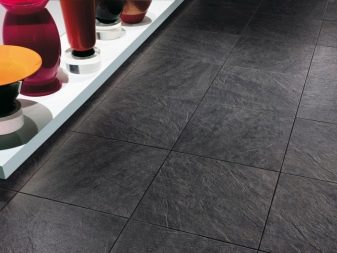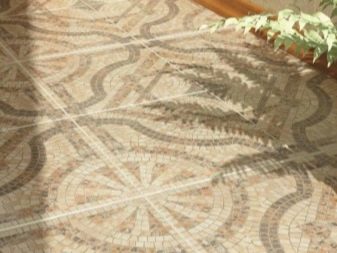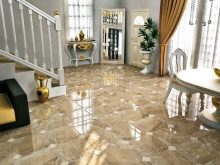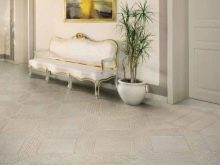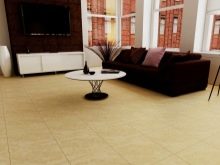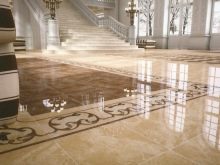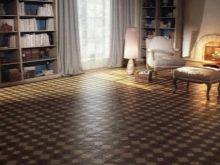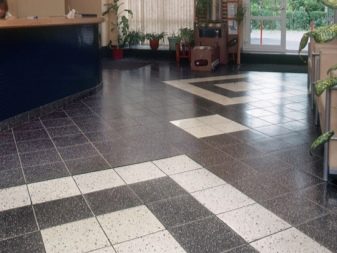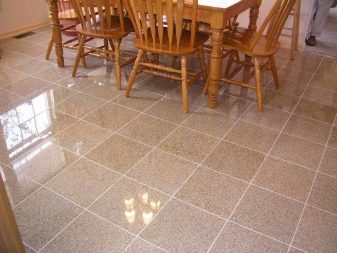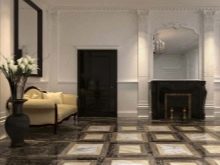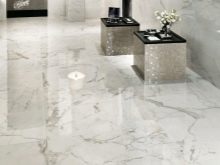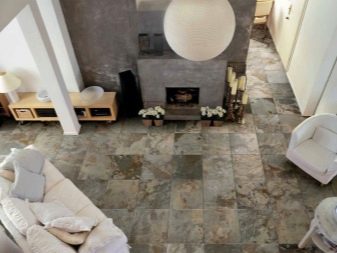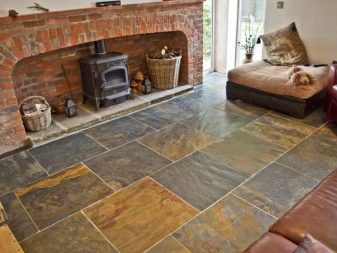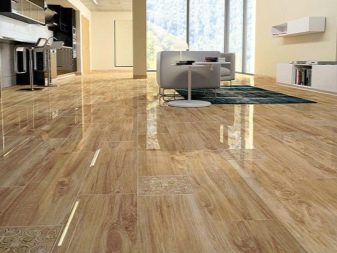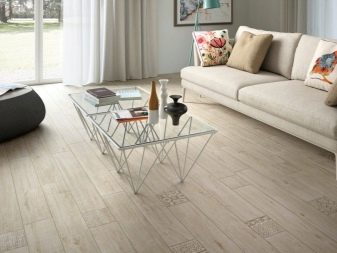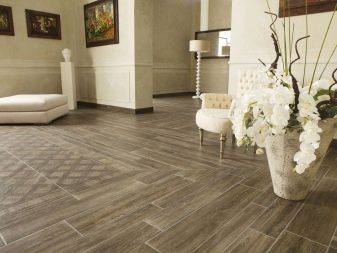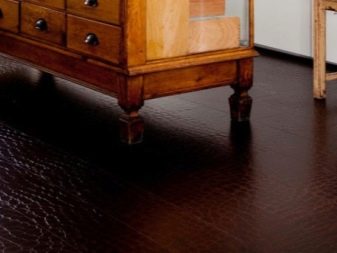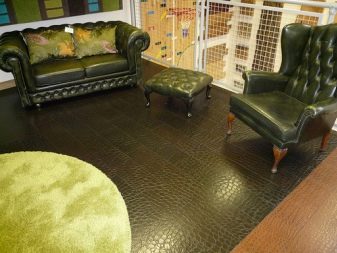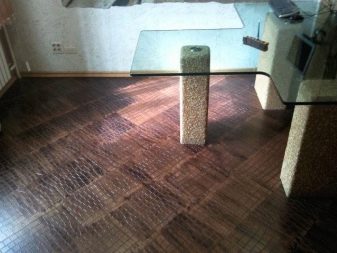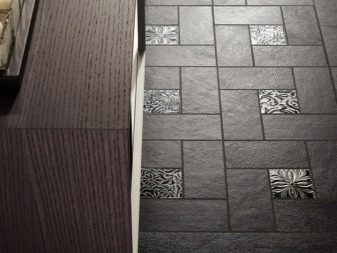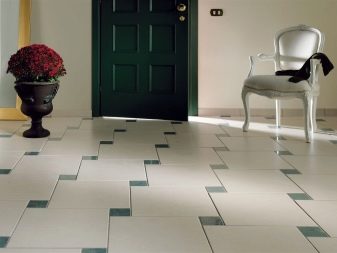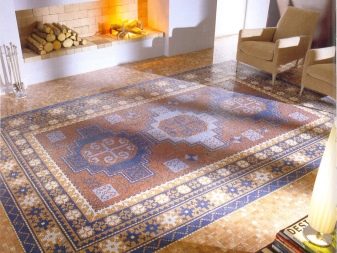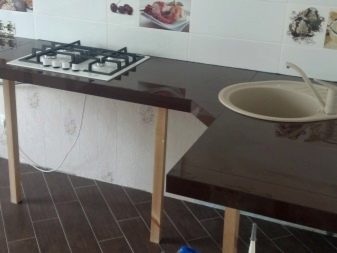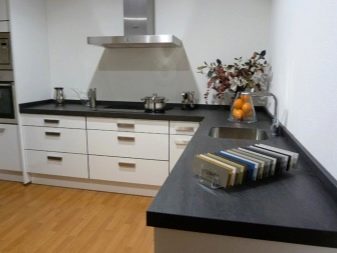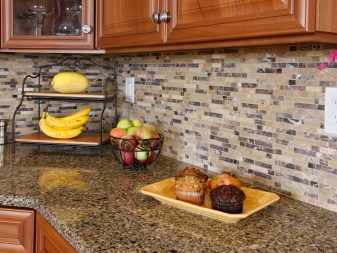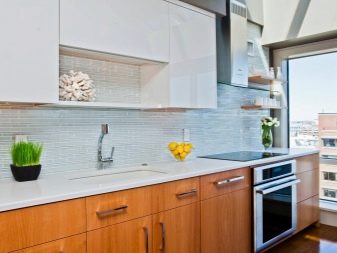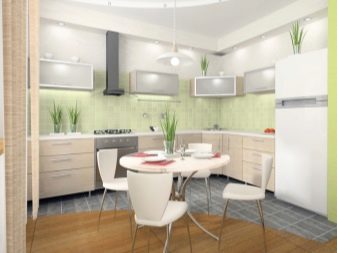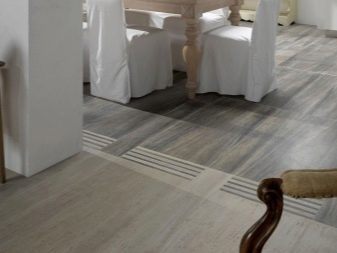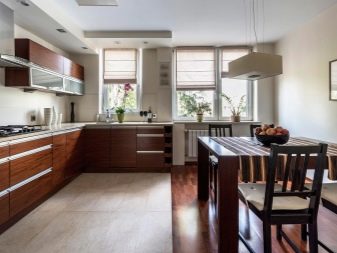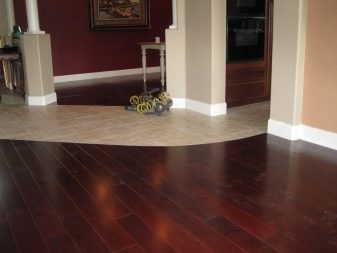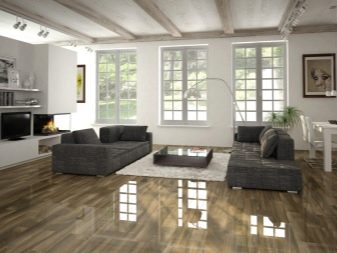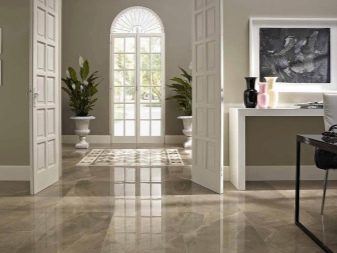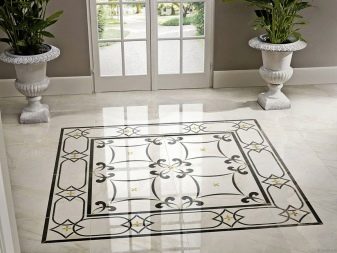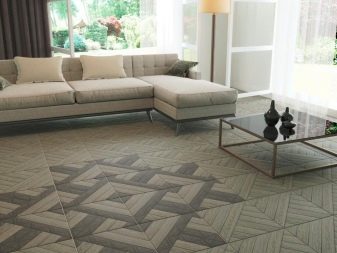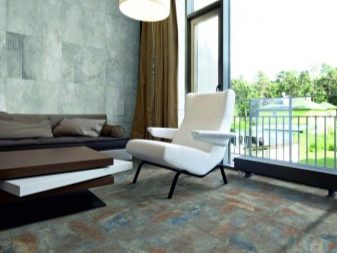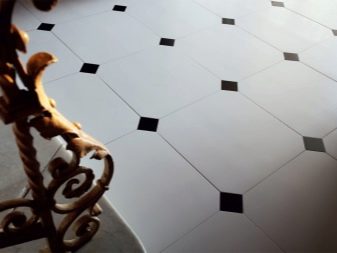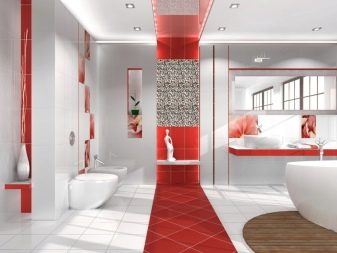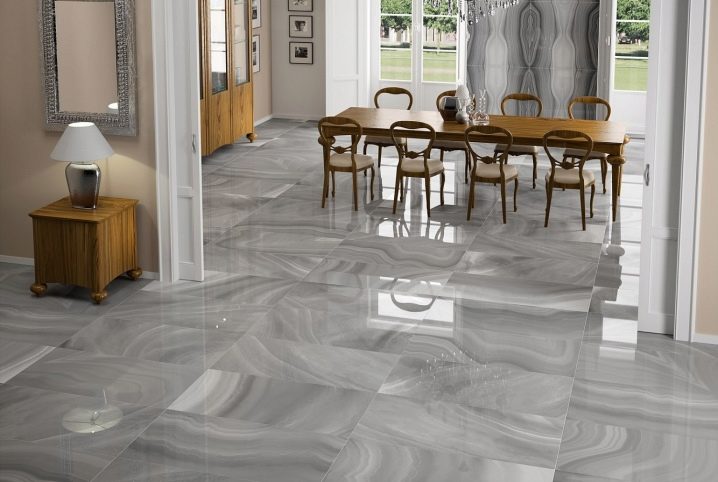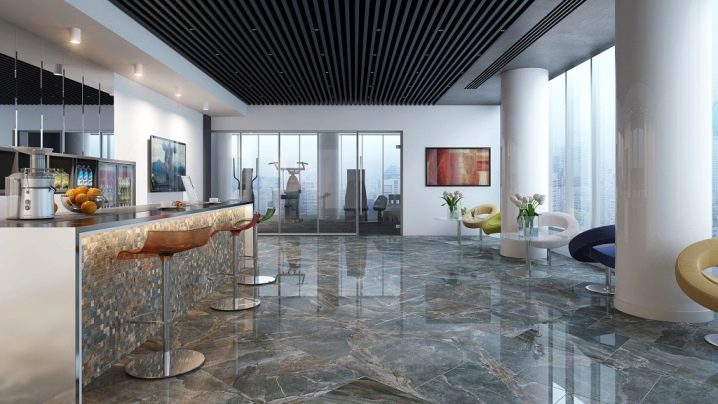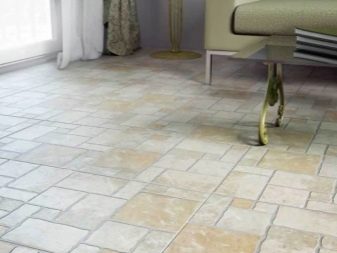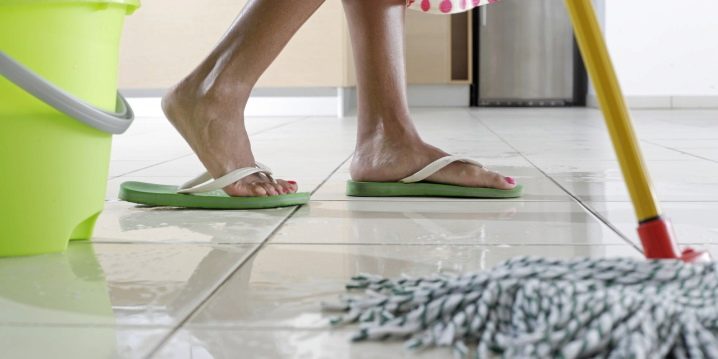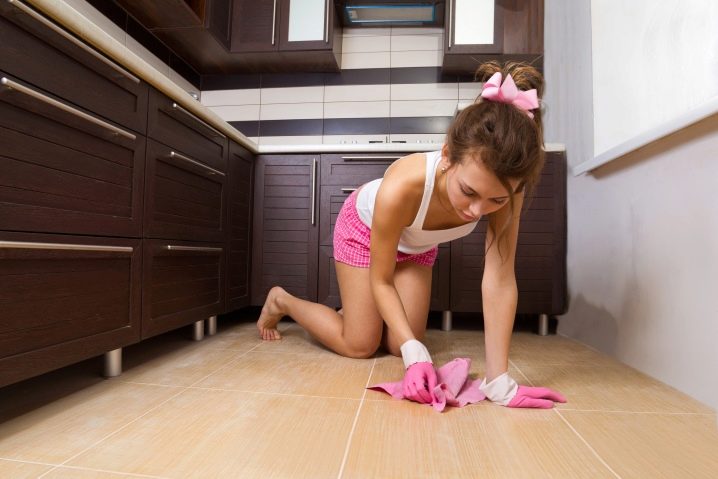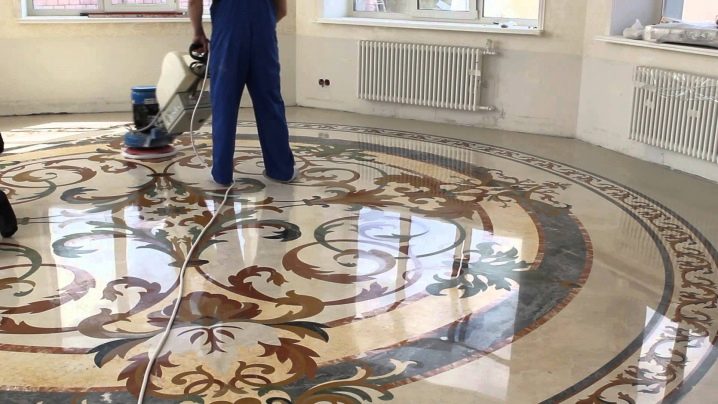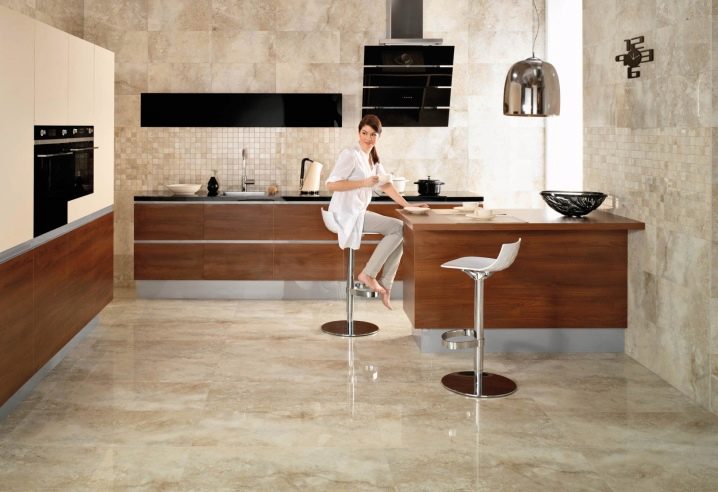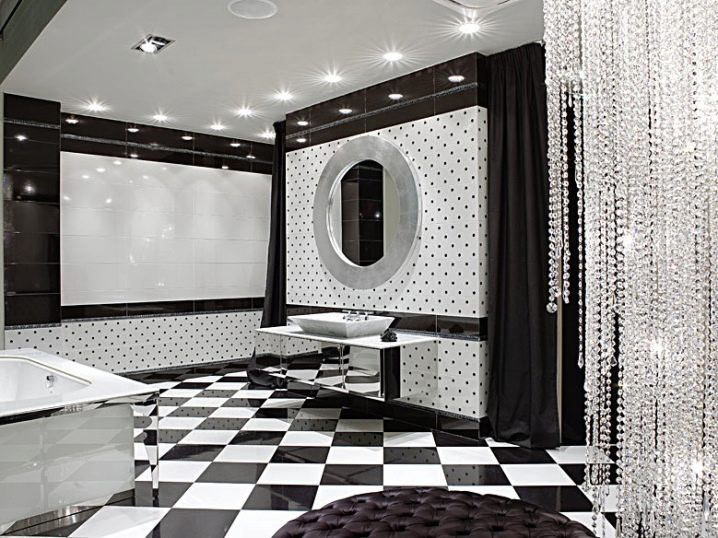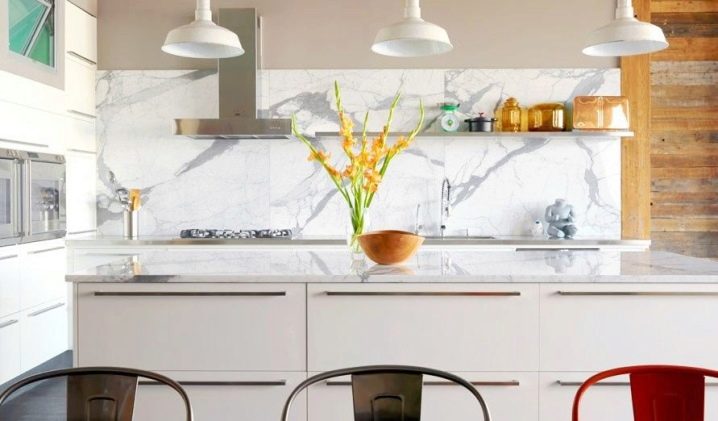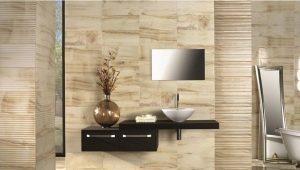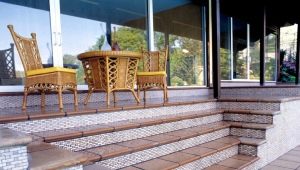Porcelain tile for floor: the pros and cons
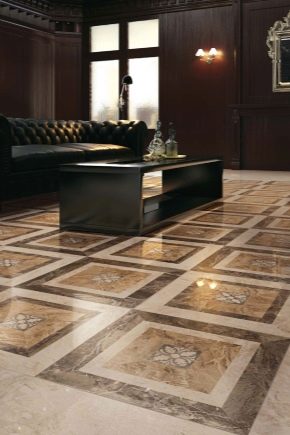
The porcelain tile is a popular and high-quality facing material. It organically combines good external and production characteristics, which is why it is in great demand. But now manufacturers offer different types of porcelain stoneware, which are sometimes difficult to pick up without examining their advantages and disadvantages.
Special features
- The main feature of porcelain tiles is that it is considered the most durable facing material. There is a generally accepted scale of strength, in which porcelain stoneware is in second place after diamond. It is stronger than ordinary granite. That is why these floors serve for a long time and are well tolerated by any mechanical impact.
- Porcelain tile has moisture-proof properties. The characteristics of this material show that it has the lowest possible porosity. Thus, water absorption is practically absent, since this indicator is no more than five hundredths of a percent. That is why the coating can be used in any, even wet areas.
- Since such a tile creates a reliable barrier to water, it also withstands high temperatures. Porcelain tiles can be laid even in outdoor areas. External properties of this material do not change, even when the temperature drops to - 50 degrees. This is what makes ceramic granite different from ceramic floor tiles. At low temperatures, the latter crumbles and loses its quality and external properties.
- Another characteristic feature of porcelain is its durability. It almost does not wear out and retains its presentable appearance for decades. The ceramic granite tile is divided into 5 classes, which determine its durability:
- First class coatings are wall varieties.
- Second class porcelain stoneware is used for finishing the floor in residential premises with low traffic.
- Models of the third class are designed for more passable rooms. They maintain permeability of about a hundred people per hour.
- Fourth-class models are purchased exclusively for flooring in public places, where the permeability is very high and amounts to more than a few hundred people per hour.
- Fifth-grade porcelain tile is designed for finishing floors at railway stations and other places with intensive traffic.
- All models of porcelain tiles in addition to specifying the class have on the package other markings. The most frequently indicated number of firing cycles of the material, the thickness of the ceramic-granite tile, the bending strength, resistance to abrasion, the coefficient of friction of the surface. Each pack indicates whether the tile is for walls or floor.
- A distinctive feature of such a tile is its hardness, which is also indicated on the packaging with special markings.
- Also on some packs there are markings that indicate the recommended place to use a certain type of porcelain stoneware. This can be an airport, hospital, factory, sports complex or home apartments.
- Another characteristic feature is the presence of a large number of formats of porcelain. Manufacturers are models for rooms with different area. For large rooms, elements of a large-sized tile are provided, but for small rooms, manufacturers present small porcelain stoneware.
- Porcelain tiles are quite easy to lay. Many models of such tiles do not require special base preparation.
- Another characteristic feature of porcelain tiles is the ability to choose the thickness of the plates. Manufacturers represent models with a thickness of 7 mm to 3 cm. Thus, the thicker the tile, the more reliable and durable the flooring will be, since thicker models can last much longer than thin ones. Tile thickness has a direct relationship with the factor of wear resistance and abrasion of the coating.
- The next feature that characterizes porcelain is high resistance to physical exertion. Porcelain tiles can withstand a load of 2,000 N. This is one of the highest degrees of resistance according to the generally accepted classification. Flexural strength is as high as possible.but specific indicators still depend on the size of the tile and its thickness.
Advantages and disadvantages
Porcelain stoneware coating has a number of advantages:
- It is resistant to external influences, including the effects of fire, water and temperature changes.
- Some manufacturers even point out that porcelain stoneware can last up to 100 years. That is why the great advantage of this coating is its durability.
- Porcelain tile is difficult to damage, because it withstands almost any blows. Even if you drop a heavy pot or a frying pan on the floor, not a trace will remain on the tile. There are no scratches, chips and other effects of mechanical effects on the coating.
- The great advantage is the affordable price of such coverage. Although similar tile models are more expensive than ceramic products, in general, the cost is reasonable and justified. Especially when you consider that the floor can last for a long time.
- The next advantage is the environmental friendliness of this coating. This is due to the fact that porcelain tiles are made only from natural elements.Thus, such a lining is absolutely harmless to human health.
- The advantage of such floors can be considered a large number of interesting textures and relief models that are manufacturers.
- Due to the special production technology, porcelain is very dense and heavy. This is due to a strong press during production and subsequent calcination of the material at a temperature of 1300 degrees. Thus, the components in the composition of this coating fuse strongly without forming air bubbles. That is why porcelain has the highest hardness and reliability.
But some models have several drawbacks. These include:
- Unreasonably high prices for imported models. As a rule, this feature does not apply to domestic firms.
- Virtually all porcelain with its strength is quite fragile. This applies not laid and fixed tiles, and cases of transfer or transportation of not yet built products. Thus, when falling plates can be easily broken.
- Another disadvantage is the low level of thermal conductivity.Coverage is very cold, and walking on it barefoot is not very pleasant. If you do not foresee the installation of a warm floor, you will not be able to walk barefoot on such surfaces at home.
- Buyers also note other disadvantages, for example, the fact that such a coating is difficult to cut and trim its edges during installation. When cutting, many people have chipped corners, and cracks can also appear.
- Installation makes it difficult and a lot of weight of such plates. That is why it is rather difficult to carry out the installation without assistance.
- Almost all tile models have one negative feature - they are very slippery. Stoneware is no exception. Smooth models cause strong slip and risk of injury. Moreover, since the coating itself is very hard, if you fall on it you can get injured. This is especially true of young children.
- After laying the ceramic granite tile, it becomes difficult to clean the joints connecting adjacent elements. Dust and dirt are often clogged there, so the coating requires regular cleaning.
Kinds
Brushed stoneware
This type of tile is also called unpolished.This is due to the fact that after the coating is roasted, it is not subjected to additional processing. It does not differ special aesthetic qualities, but it is the most durable compared with other varieties of this coating.
It is just such a porcelain stoneware that is most difficult to scratch and damage. This is a model that belongs to the highest class of durability. That is why you can put such coverage even in the most passable places.
It is possible to use porcelain stoneware in rooms with a high load on the floor. For example, it is suitable for laying in garages and other buildings for technical or household purposes. Since matte porcelain is not polished, its surface is slightly rough. Thus, the tile is protected from slipping and ensures you maximum security.
This porcelain stoneware is more porous than polished and glazed models. Since the coating does not undergo further processing, air bubbles and pores remain on it. Thus, oily stains and some dirt can be eaten into the surface.It is a little more difficult to care for him than for other types of porcelain stoneware.
Polished
This type of coating is treated with special abrasive materials and has a smooth texture. The tile becomes brilliant due to polishing. This cover looks elegant, glossy shine adds to the rooms in which it is put, charm and elegance. It is often placed in public places of administrative type. In addition, this treatment allows you to enhance the depth and color saturation.
But this stoneware is very slippery. If you walk on it in raw shoes, then there will be a chance to slip on it. At the same time, the tile structure also deteriorates a little, since polishing removes its top layer. This causes a decrease in the density of the coating and leads to greater vulnerability of such tiles.
Manufacturers have provided different ways to deal with these disadvantages of polished porcelain. To increase the friction force, the floors of such tiles are specially rubbed with wax in order to reduce the likelihood of a fall due to the negative impact of water.
Polished stoneware finish both floors and walls - it looks very noble on any surfaces.In addition, it is traumatic only in the cold season, and this problem can be solved by placing rugs at the entrance so that people wipe their feet on them at the entrance.
The appearance of this coating overshadows many shortcomings. In addition, it is easy to care for smooth ceramic granite. With it, you can quickly erase stains and dirt that are not eroded into the structure of floors. But it can remain divorce, if the wrong care for the coating. Now manufacturers offer a wide selection of sleek models with a wide variety of prints and patterns.
Semi-polished or lappatirovanny
This coating was invented by the Italians, and the original production technologies are still used to create it.
The tile is polished quite a bit, so its surface becomes not too smooth, but some areas are still polished. Thus, it turns out an elegant combination of polished tile zones with rough ones, which looks unusual. Some of these models resemble woody texture.
In addition to the combination of the external characteristics of matte and glossy porcelain, it includes all the advantages of both types.It has good water resistance and resistance to external influences. This moderately slippery material is easy to maintain and operate. In addition, they can trim the premises in places with high traffic.
As a rule, semi-polished products are created as follows: the top layer is removed from a standard unpolished tile, then the surface is partially polished.
Polished
This kind of porcelain tile has an interesting texture. Products are subjected to satinizing, which allows to achieve the visual effect of matte and semi-archite tile surface. When finishing the top layer using mineral salts.
This model has a lower quality of wear resistance than the previous ones, but its decorative qualities may surpass the characteristics of other types. Due to the special production technology, the coating does not slip at all and at the same time it looks luxurious.
The strength of the material is not inferior to the artificial stone, but still it is not recommended to lay in public places. As a rule, it is used for finishing apartments and houses, as it is intended only for home use.This tile is expensive, but it looks decent.
Structured
Such models have an interesting relief texture. Due to the special production technology, structured porcelain tile has the ability to imitate almost any material. It can be models of wood, travertine, brick, marble, stone.
Manufacturers even present models that can imitate leather and woven textures.
In terms of quality, it looks like polished porcelain stoneware. It is perfect for home use. The aesthetic qualities of the material are at a high level: it looks beautiful and interesting.
Particularly popular models of porcelain tile mosaic of stone. Most of these coatings have an interesting relief texture, so they protect households and guests from slipping. Even if the floor gets wet, it will be difficult to slip on it.
Glazed or smalti
Such coatings look very similar to ceramic tiles. This similarity is due to the fact that both types of material are covered with an additional layer of glaze.
In the production of glazed porcelain stoneware used technology double pressing. Thus, the finished compressed composition is additionally compressed with vitreous enamel, which makes its color brighter and more interesting and allows you to fill the house with a wide variety of color solutions and combinations.
These models are not intended for use in public places at all and belong to the first class of wear resistance. Although such plates have a dense base, they are not as reliable as previous species.
Small mosaic
This porcelain stoneware is considered the most durable and reliable, because the tiles have a minimum size. Breaking or damaging tile elements is very difficult. Mosaic floors are almost invulnerable to external influences and therefore durable. In addition, outwardly, this coating looks very impressive.
The floor surface can be trimmed with several hundreds of multi-colored tiles, creating an interesting palette. At the same time use various ways of a combination. Mosaic stoneware tiles are laid in the form of abstract patterns, as well as geometric ornaments and shapes.
The chess layout and laying in the form of pre-designed ornaments is also popular. At the same time, mosaic porcelain tile is suitable for almost any style and looks presentable.
Rectified
This material has an unusual structure. These are models that may vary in size and size. After finishing under the influence of high temperatures, interesting geometric patterns appear on the tile. Its texture varies from one element to another. In this way, thanks to the rectification procedure, the tile becomes perfectly smooth and straight.
In addition, it has the right size, which is convenient to finish the floors in the premises. Therefore, with such models, you can avoid the additional need to trim tiles. The edges are treated with special lasers on machines and sealed using abrasive tools. In this way, when laying the rectified tile can be mounted in such a way that the seams are practically invisible.
The coating will look monolithic and complete. At the same time, it is not inferior in aesthetic properties to previous types of stoneware tiles.
Since there will be no seams between the elements, they will not be so securely fastened. This can lead to increased wear of the tile. It will not be so resistant to mechanical stress.
This coating is not placed in rooms that are characterized by temperature extremes, it is also not adapted for underfloor heating. Despite the fact that the coating is ideal in size and external qualities, it is quite capricious to the conditions of operation.
Dimensions
The size of the tile depends on the characteristics of the floor covering with this material. Models 60 by 60 cm suggest installation on high-quality and reliable adhesives. At the same time the basis has to be ideally equal.
A model with parameters of 30 to 30 cm suggests the admissible presence of defects and irregularities on the floor. Small tiles allow you to hide them.
The best models are the size of 45 by 45 cm. They are distinguished by their versatility, they can be laid in almost any room, regardless of its size and purpose. That is why such dimensions are in great demand.
In addition to standard sizes, there are models of non-standard parameters.Some products are about 30 cm thick, so they are placed only in industrial premises.
Also, there are larger models 1200x600 mm. You can pick up and small models 5x5 cm for mosaic.
The specific size can be chosen based on the model range that the manufacturer represents, or customize it. Standard ceramic-granite tiles can be trimmed at home with a grinder. To do this, use a nozzle in the form of a diamond disc.
Dimensions are a very important characteristic of a tile. These indicators are necessary to calculate the amount of material that will need to be spent on stacking in the room. But when calculating in addition to multiplying the parameters of the tile by the area of the room, you must add an additional 10%. These additional 10% you can use in order to hide flaws and cut off small pieces. So it will be more convenient to dock, and the floors will look really perfect.
Design
When choosing a ceramic granite tile, it is necessary to take into account its design. With its beauty, it should be non-marking, in order to determine the practicality of flooring in general.Manufacturers now present a wide variety of stylistic design options. In this case, a specific design must be selected depending on the style of the room where you plan to install such tiles.
- Now a very popular and fairly neutral option is finely speckled tiles. The speck is presented in the form of small dots on a monochrome background. In another way, this design is called "salt or pepper." It does not show minor damage. In addition, this tile is often matte.
It is very versatile and perfect for laying in the kitchen, in the hallway or in the hallway. It is she who often trim production facilities where design matters. In addition, this tile is laid in modern style interiors, for which the presence of bright accents is not typical. Usually these are monochrome white, beige, gray and black models with white or black speck.
- In modern kitchens often put marbled stoneware. It fits perfectly into the interior, designed in the style of a classic. In addition, it can be put in almost any room.But at the same time it is desirable that its design was white or black and white.
- Some models imitate natural stone. It may be small or large items. Usually they choose multi-colored models of large stone slabs with an already printed pattern and lay them out in a certain order. This design looks bright, but restrained.
- Another interesting design move - use of texture ceramic granite tiles with woodgrain. Such a coating looks natural, and due to imitation of wood, the floors seem to be massive. This floor is the most practical. Such floor tiles are often used in kitchens in the classical style.
Manufacturers provide a choice of very realistic woodgrain tiles of different colors. It can be models under an oak, an ash-tree, wenge, mahogany, and also other valuable tree species. You can also find interesting models for parquet or laminate.
In addition, it is customary to use such coatings in studios, divided into different functional areas. There you can simultaneously lay a tile under the tree and install a natural wooden floor or laminate flooring.In addition, many manufacturers are large-sized stoneware woodgrain tiles, which has a pattern laid out of mini-elements. These can be models for Christmas tree, large plates for the board, or items with a pattern for the deck.
- For the most sophisticated interiors fit porcelain stoneware. It is often used not as the main material for decoration, but as an element for placing accents. It can be put in the center of the room to imitate a carpet or just focus on certain details. Designers are interesting models of monophonic type, but they differ in bright colors.
This type of porcelain stoneware is dyed with natural substances, therefore monocolor elements are rather expensive. They are laid out on the floor in the form of different patterns and abstract patterns; these can be geometric prints or coverings arranged in a checkerboard pattern.
In children's rooms or areas for games such elements are laid out using the panel or patchwork technique. In addition, you can create an interesting color pattern and lay out different patterns and ornaments.
Ways to use
Porcelain tile is most often used for finishing the floor in the hallway or in the kitchen. This is due to the fact that it is in these areas that one often encounters high humidity and strong mechanical effects on the floor. It is in these rooms that puddles or wet evaporations on the floor are often formed.
Thus, in these rooms usually use textured matte stoneware tiles. With this material You can finish the balcony floor as well as the floors outside, for example, in the gazebo, on the terrace or on the porch. This is due to the high strength and frost resistance of such materials, so they can be mounted in unheated rooms.
Although porcelain stoneware is a material that is primarily used for flooring, it is also used for other purposes. With it, trim the countertop in the working area of the kitchen. Thus, it will be possible to cut it with a knife, and the kitchen set will not be damaged by cuts and scratches.
In addition, hot pans and pots can be put on such a tabletop. In this case, the tabletop does not absorb neither smell, nor dirt, nor fat. This coating is also easy to clean.To do this, most often acquire a smooth stoneware tiles.
The material is laid in the apron area.. There it is necessary so that oil splashes and grease do not stain the walls. And since it is waterproof, steam will not spoil it.
This means that the kitchen will look beautiful, and cooking and cleaning on it will be much easier. In this case, you can use both large and small porcelain, selecting the most interesting design models.
Combining
To decorate the whole house with ceramic granite tiles is not accepted. As a rule, it is used for laying in separate functional areas or rooms. But at the same time often used various techniques of combining materials and textures. For example, models for parquet often combines with natural parquet.
In the large living room, the kitchen area can be laid out with such tiles, and the dining area and seating area with a sofa can be decorated with natural wood or even carpet.
As a rule, when combining they try to combine materials that have completely different properties, but slightly similar textures. Thus, it is better to combine the ceramic granite tile with a thicker and more durable coating so that the floors have the same level.
It is important to pay great attention to the docking.Porcelain tiles can also be used on two-level floors. They spread part of the threshold on the two-level floor. Fine ceramic granite tiles trim the plinth. This facing looks very harmonious.
You will learn the rules for laying porcelain stoneware on the floor in the next video.
Manufacturers
The top brands are ranked by tile manufacturers from Spain and Italy. They are distinguished by exquisite design and high quality. Spanish brand El molino Presents a lot of good models that have already become popular.
These products belong to the Boreal El Molino collection. Such a ruler is mainly matte models intended for home use. Most of these materials are made in pastel colors and have a discreet design. Models from the Formula El Molino collection, by contrast, are presented in the form of polished tiles. This collection uses beige, black, gray, burgundy colors. Models have decor in the form of edging or speckle salt / pepper.
Italian Marazzi Italy brand presents bright and stylish patterns of porcelain stoneware tiles, including a mosaic variety. The basis of most of these products used European design. The tile is designed for the interior in the style of minimalism, loft, hi-tech, Provence.
Customer reviews show that such tiles have a decent quality and reasonable price, which is why it is popular in many countries around the world.
Belarusian products are in demand too. brand keramin. The manufacturer relies on increased strength and maximum environmental friendliness of the material.
In Russia, the leading position in the market of porcelain tiles takes brand Estima. In the production of such coatings using pigments that mimic natural materials. And all raw materials are completely hygienic and safe.
Popular polls were created in Poland brands Tubadzin and Polcolorit, producing different types of tiles, including porcelain stoneware products. Chinese porcelain stoneware is also in demand among buyers because it has a low cost.
Tips for choosing
When choosing a tile of porcelain stoneware, it is necessary to consider the purpose of the room where you are going to lay it. It is better not to purchase structured and embossed porcelain stoneware for indoor-type premises or for household buildings. For such a tile you overpay several times, but at the same time it can not withstand the loads on the terrain and quickly wear out.
If indoors on such a floor they mostly wear shoes, or if you lay out porcelain stoneware on the street, for example, on the floor in the gazebo, then try to get smooth material. This is due to the fact that it is rather difficult to clean the dirt that has fallen on the textured areas, and you will have to use brushes and special care products.
Tile models should be both beautiful and functional. In addition, low-cost options may have a poor caliber and vary in size. Thus, you will spend a lot of time and effort on cutting the material.
.
Choosing a stoneware tile, Give preference to models that were released in one batch. Otherwise they may differ in color and texture. Such differences can even spoil the interior of the room and disrupt its harmony. Choosing a tile, pay attention to the size of the room. In addition, factors such as color, shape and size of tile elements should be taken into account.
In large rooms, you can use dark porcelain or a combination of dark and light, but small rooms such a floor can visually reduce even more.That is why here you should use light tile. In addition, to fill the room with space and air, it is better to give preference to glossy or glazed models. They will decorate the interior and make it more interesting.
Consider how you will be laying the porcelain, and how it can be used to expand the room. Before buying, you need to make all the calculations and select models that have a good value for money. Choosing porcelain, buy it with a small margin.
If your choice is between large and small elements, then Remember that smaller tiles are more practical and are suitable for laying on an unfinished floor surface.. But large elements require additional finishing or installation of the subfloor.
In addition, the size of the tiles should be proportional to the size of the room: the wider the room, the larger should be the floor tiles.
Care
Since the porcelain tile has a low percentage of water absorption, it is absolutely not afraid of wet cleaning. But in this case, the seams between the tiles become vulnerable. Therefore, initially it is necessary to remove all the dirt that has accumulated between the elements of the tile, and then produce a wet cleaning of the entire floor. Choosing care products for porcelain stoneware, you can give preference to special chemicals..
Buying cleaning supplies, it is necessary to study their composition. It is important that it does not include acids.. They are not harmful to porcelain, but may adversely affect the materials from which the seams are made. Can be used to clean the coating of the brush, but you should try to avoid the use of hard abrasives, as they can scratch the coating or damage it with frequent use.
Before moving on to a wet cleaning, you must wipe off the dust or use a vacuum cleaner. The vacuum cleaner allows you to remove solid particles of sand and small stones and significantly facilitate cleaning. Alkaline products can be used to remove grease and dirt. But stains from paint or varnish is best removed with acetone.
In order to provide proper care for the porcelain stoneware tiles, it is necessary to regularly not only clean, but also to prevent its pollution. Silicone-based products or resins must be used.. If you regularly rub such a composition into the porcelain stoneware floors, you will reduce the appearance of dirt on both the tile and its joints.
If you have a glossy porcelain, you should sometimes carry out polishing, because the coating over time can dim and grow cloudy.
In addition, smooth models should be cared for with wax-based products. They update the coverage and make it visually more presentable. In addition, if you use wax-based products, you can restrict yourself to wet cleaning without the use of chemicals.
Beautiful examples in the interior
Both in the modern and in the classical interior, fine porcelain stoneware, lined with a Christmas tree, a diamond or diagonally, looks beautiful. In addition, you can use the most interesting and intricate patterns, taking into account the advice of designers and showing creativity. In addition, it can be laid covering as vrazbezhku and ladder.
The interior of the kitchen looks beautifully decorated with the same porcelain tile of the apron and floors. This interior looks elegant and elegant. In this case, most often prefer glossy models.Black apron and glossy floor will perfectly fit into the interior in the style of high-tech or minimalism.
Another interesting option is the use of white porcelain stoneware with a glossy texture on the kitchen worktop and in the apron area. The composition of the floor will complement the composition with a similar, but contrasting black porcelain stoneware. Thus, the interior will look elegant, but restrained.
In rooms with a brighter interior, for example, in the bathroom or in the kitchen, you can use the monocolor. Such models of porcelain tiles will create a catchy and stylish design. In addition, this way you can lay out black and white elements in a checkerboard pattern for a more restrained and strict design.



